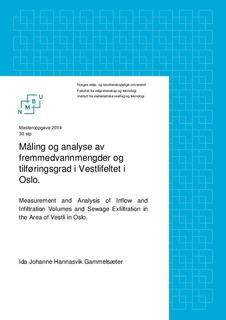| dc.description.abstract | Fremmedvann inn på avløpssystemene er et av de største problemene VA-Norge står ovenfor i dag (Vråle 2011). Fremmedvann tar opp kapasitet i avløpsrørene og pumpestasjonene, fører med seg forurensing ut via overløp og nødoverløp, øker overflatebelastningen på renseanleggene, gir dårligere renseeffekt og fører til økte drift og investeringskostnader (Lindholm 2011). Selv om 55% av avløpssystemene er fellessystemer, opplever Oslo i tillegg store mengder fremmedvann fra separatsystemene sine. Oslo har 58% fremmedvann inn på avløpsnettet. Dette gir en spesifikk innlekking på 1,54 l/s*km (Oslo kommune 2013a).
Målet med denne oppgaven var å undersøke fremmedvannsandelen i avløpsvannet og finne ut av spillvannstapet og tilføringsgraden til nettet. Vestli-feltet, et boligområde utbygd på 60- og 70-tallet, ble valgt som forsøksområde. Avlpssystemet i Vestli-feltet er separatsystem. For å finne fremmedvannsandelen ble det brukt vannførings-, temperatur- og nedbørsmålinger sammen med døgnblandprøver som ble analysert for tot-P. Målinger og prøver ble tatt fra tre kummer som drenerer hvert sitt område av Vestli-feltet. Det ble også foretatt stikkprøver og –målinger i tre overvannsnett for å finne spillvannstapet til overvannet. I tillegg ble TV-inspeksjon av spillvannsrørene brukt til vurdering av rørenes tilstand.
Resultatene viste store fremmedvannmengder, både fra direkte innlekking under nedbørsepisoder og konstant infiltrasjon fra grunnvann og utlekket drikkevann. For hele feltet var fremmedvannsandelen på 47% og tilføringsgraden på 94%. Utlekket drikkevann ble antatt å sørge for en spesifikk innlekking på 0,3 l/s*km, den nedbørspåvirkete innlekkingen for 1,5 l/s*km og annen infiltrasjon (grunnvann) for 0,2 l/s*km. Til sammen ble den spesifikke innlekkingen på 2 l/s*km, noe som er over den gjennomsnittlige innlekkingen for hele Oslo. Spillvannstapet til overvannsnettet var forsvinnende lite med kun 1-2% utlekket spillvann til overvannet.
Avløpssystem lagt etter andre verdenskrig frem til 80-tallet er i dårlig forfatning og har mye fremmedvann til tross for at de oftest er lagt som separatsystem. Det er den konstante infiltrasjonen fra utlekket drikkevann og grunnvann som gir de store fremmedvannvolumene gjennom året inn til renseanleggene. Nedbørpåvirket innlekking sørger for økte overløp fra fellessystemene og nødoverløp fra pumpestasjoner og gir dermed den største miljømessige belastningen. Tiltak som å tette drikkevannslekkasjer, drenere grøfta for høyt grunnvann, strømpekjøre eller bruke andre no-dig-metoder på lekke avløpsledninger eller å separere fellessystemer er alle gode tiltak for å redusere fremmedvanninntak. Infiltration and inflow (I/I) into public sewer lines is the biggest problem for the water and wastewater treatment in Norway nowadays (Vråle 2011). I/I reduces the capacity of the sewer pipes and pump stations, leads to pollution from sanitary sewer overflow (SSO) and overflow from pump stations, increases the surface load on the wastewater treatment plants, decreases the effect of the wastewater treatment and increases the operating expenses and costs of investments (Lindholm 2011). Even though 55% of the sewer systems are combined systems, the municipality of Oslo gets a lot of its I/I-volume from the separate collection systems. Oslo has a share of 58% I/I-water in its sewage flows. This gives an I/I-rate of 1,54 l/s*km (Oslo kommune 2013a).
The Vestli-area is a residential area built in the 60’s and 70’s. Both the soil condition and the material used in the pipes are of a poor quality and is not suited. The sewer collection system is constructed as a separate system. The purpose of this thesis was to estimate the volume of I/I and also to quantify the sewer exfiltration. Measurements of volume rate, temperature and precipitation in addition to hourly samples analyzed for tot-P was used to find the I/I-volume. The measurements and samples were taken from three manholes that collected wastewater from three areas in the Vestli-area. Also samples and volume rate measurements from three storm water collection systems was used to find the sewer exfiltration. In addition CCTV-inspection was used to determine the state of condition of the pipes.
The results showed a large volume of I/I, both from the rainfall derived I/I (RDII) and from the constantly infiltration of groundwater and from leaking drinking water pipes. For the entire area the I/I-volume was 47% of the entire sewage flow and the sanitary sewer flow was 94%. Water from leaking drinking water pipes gave an I/I-rate of 0,3 l/s*km, the RDII gave 1,5 l/s*km and groundwater infiltration gave a rate of 0,2 l/s*km. Altogether the I/I-rate was 2 l/s*km, more than the average I/I-rate of Oslo. The sewer exfiltration rate was small, only 1-2% sewer loss was measured in the storm water collection system.
Sewer collection system constructed after the Second World War and up to the 80’s is in a bad condition and has a big I/I-rate even though they are constructed as separate systems. It is the constant infiltration of leaking drinking water and groundwater that gives the large annually volumes of additional flow to the wastewater treatment plants. RDII increases the SSO’s from the combined sewers and the overflows from the pumping stations and therefore gives the biggest environmental pollution load. Reducing the drinking water leaking, draining the ditch to prevent groundwater infiltration, sewer rehabilitation with no-dig methods and separation of combined sewer collection systems are all good actions to prevent I/I to the sewer systems. | nb_NO |
